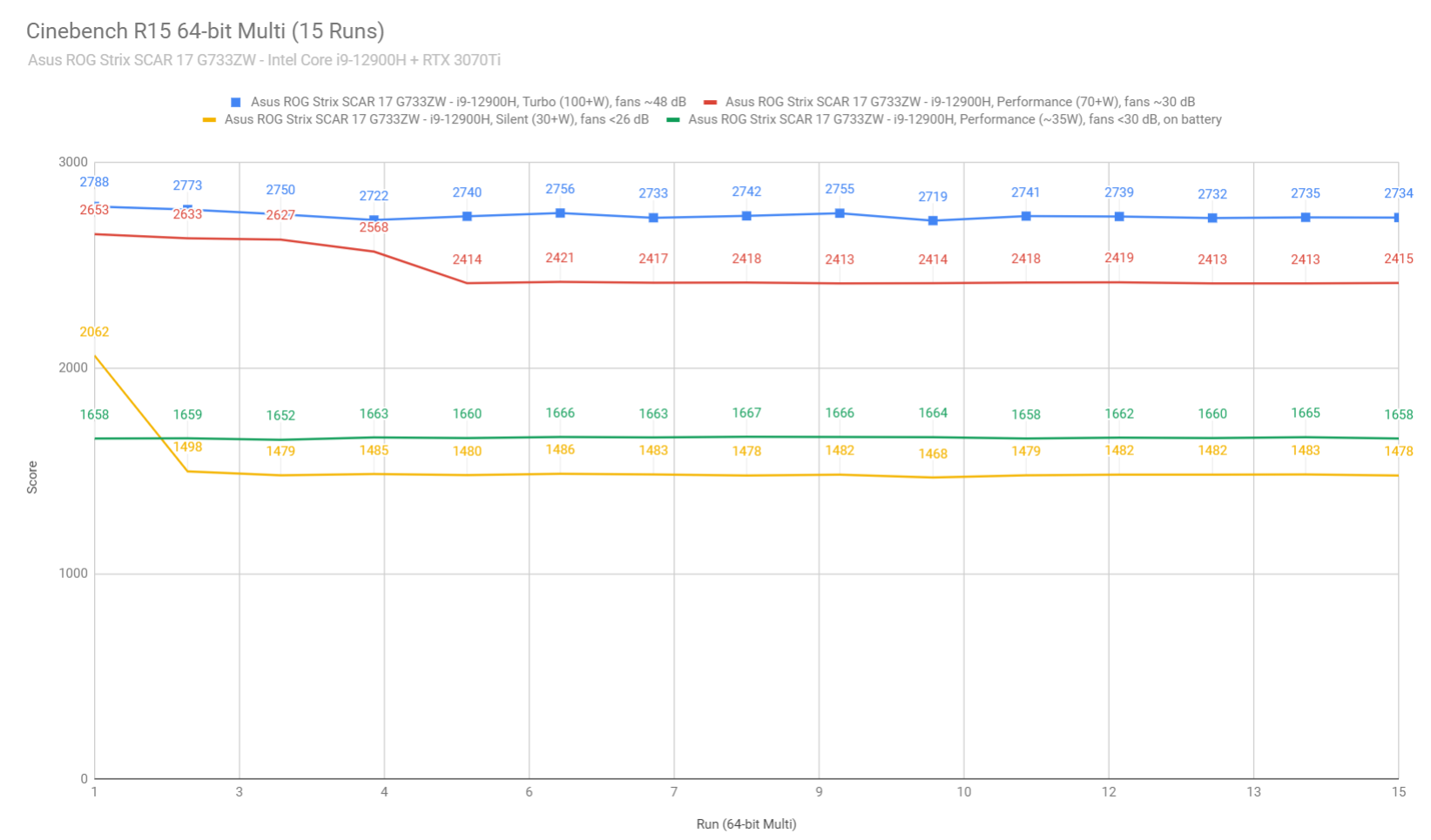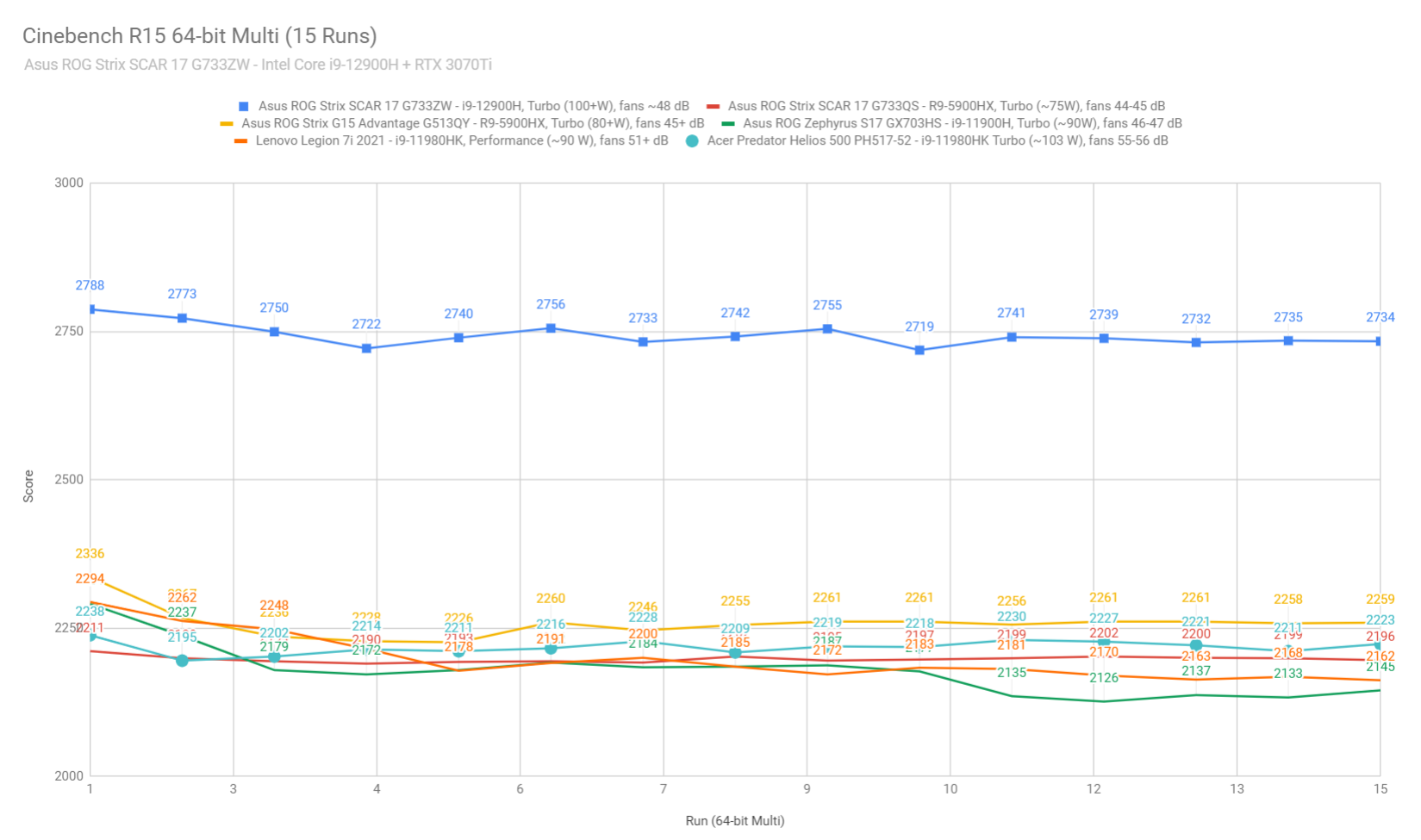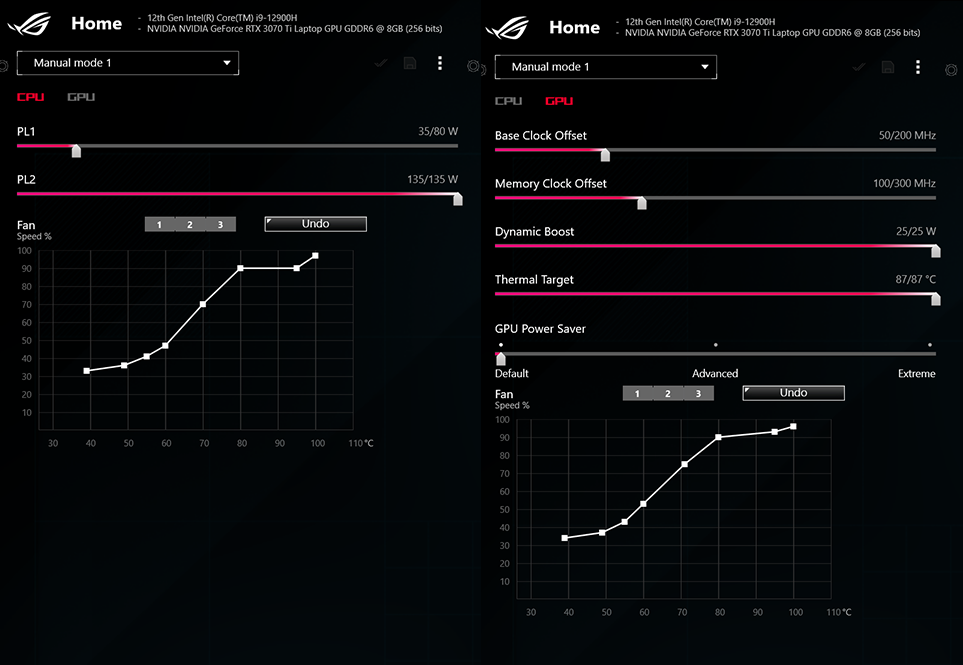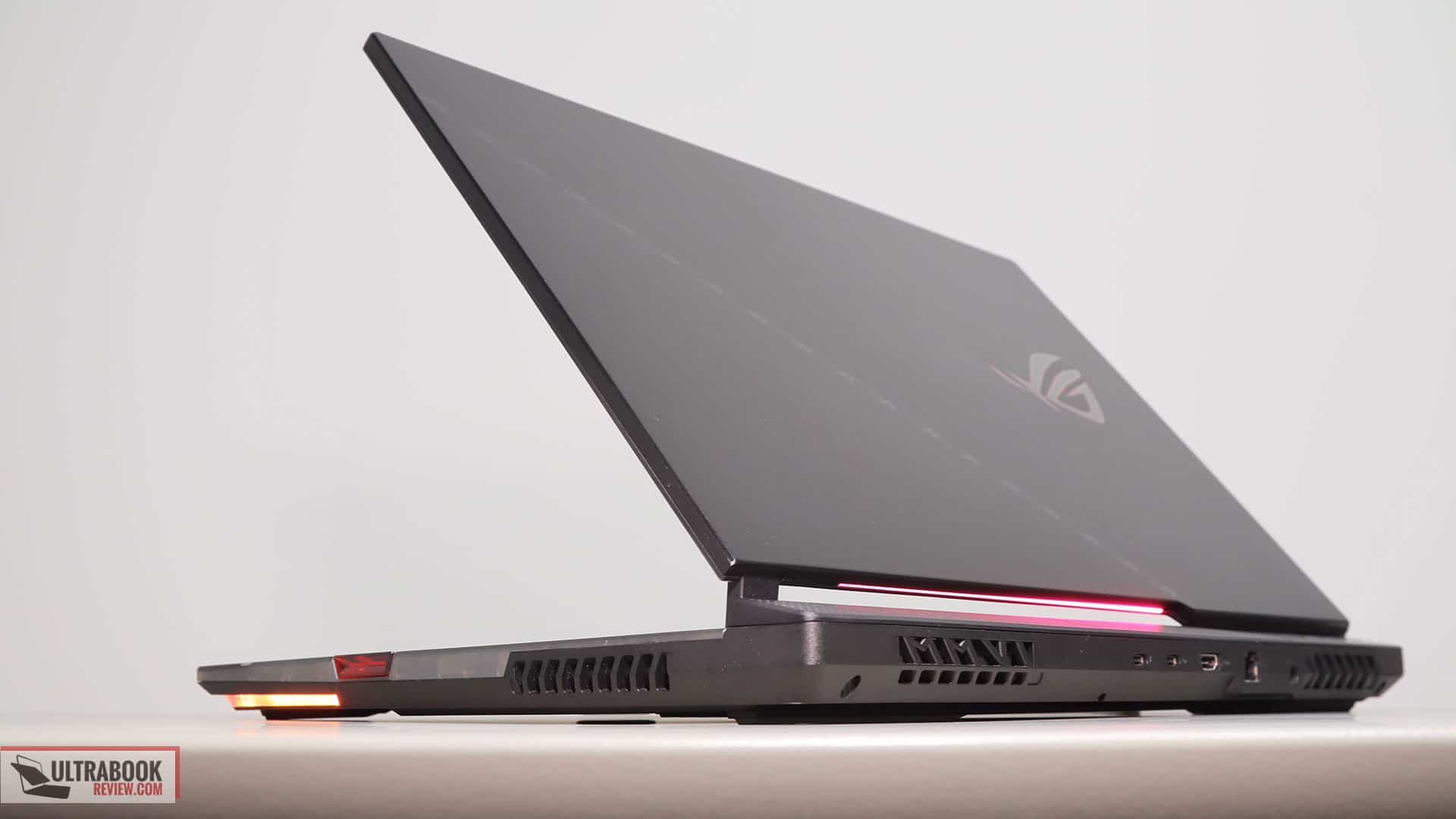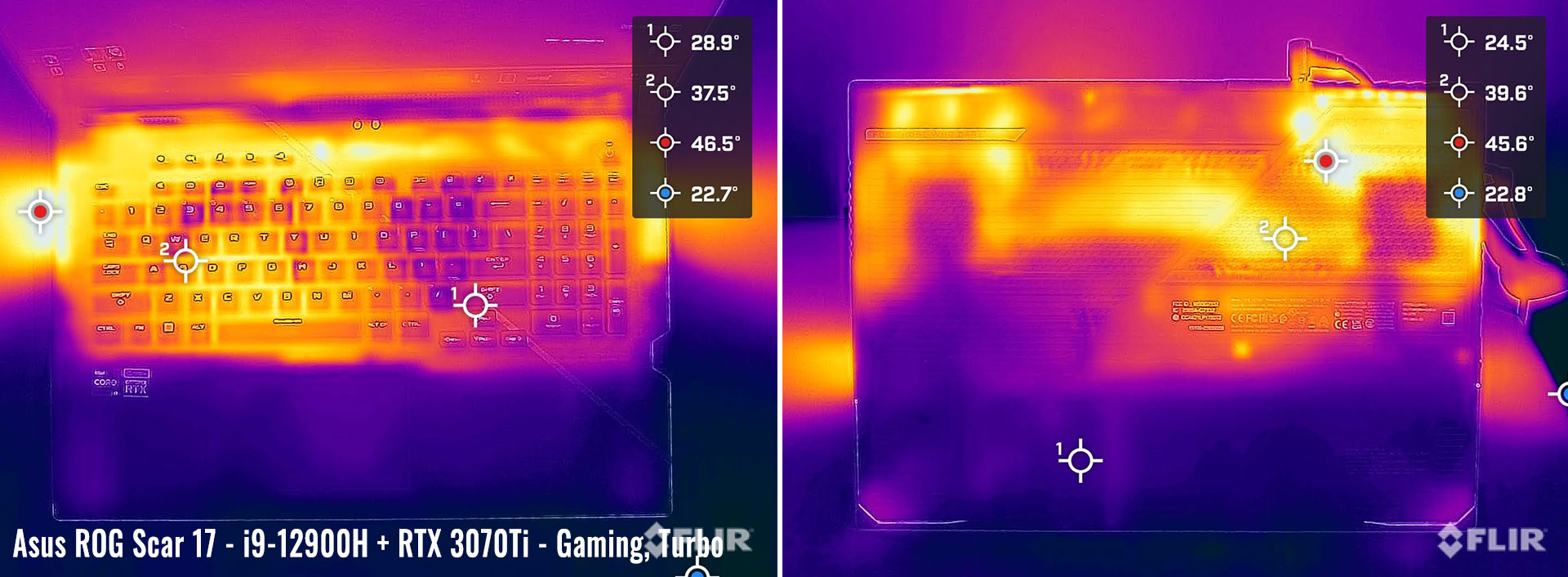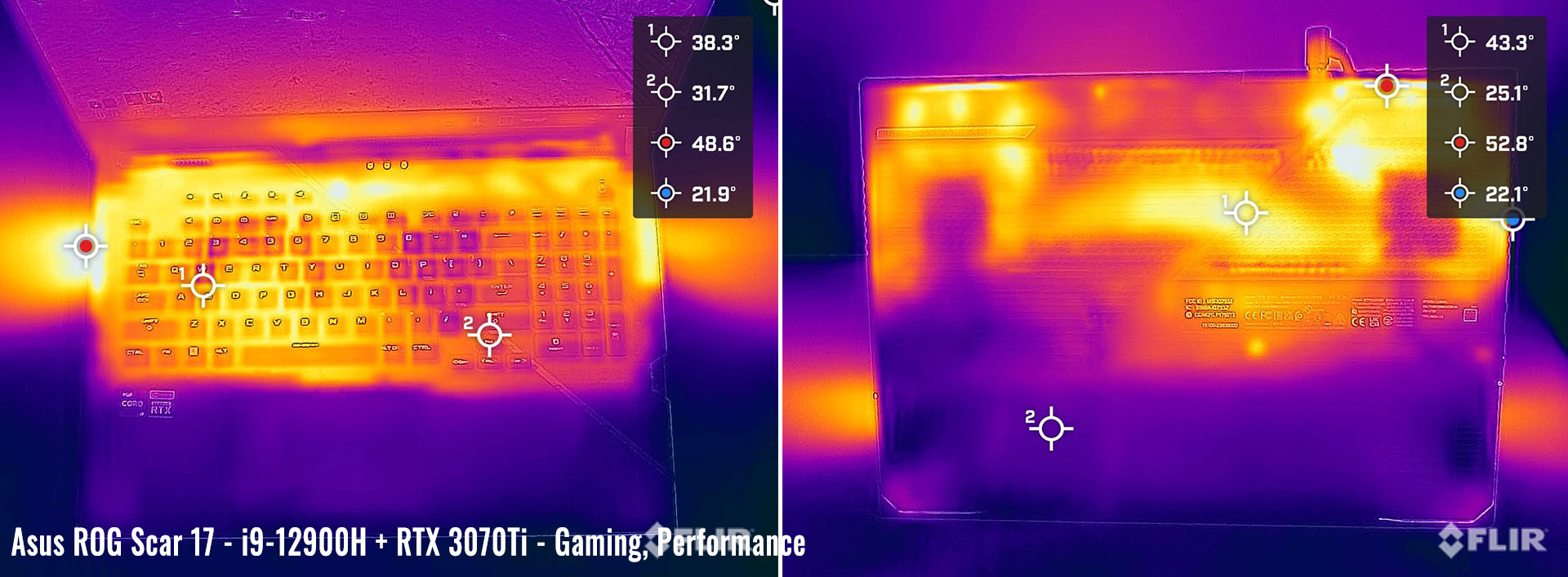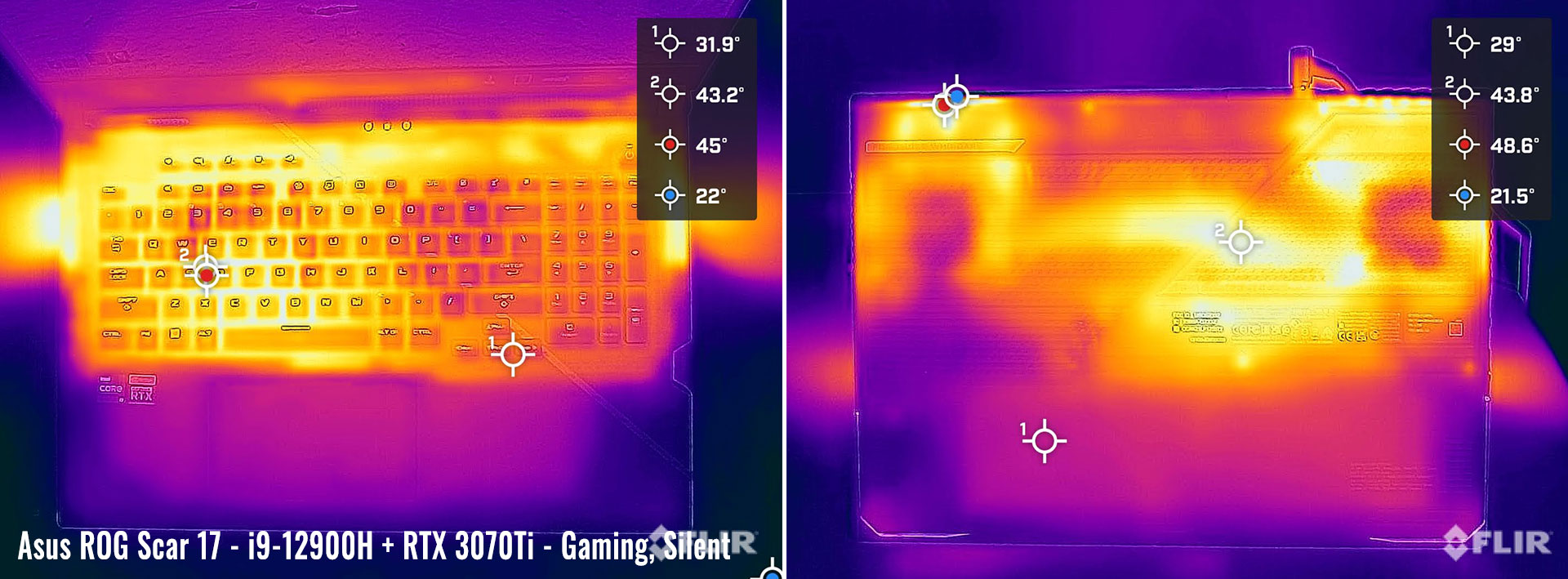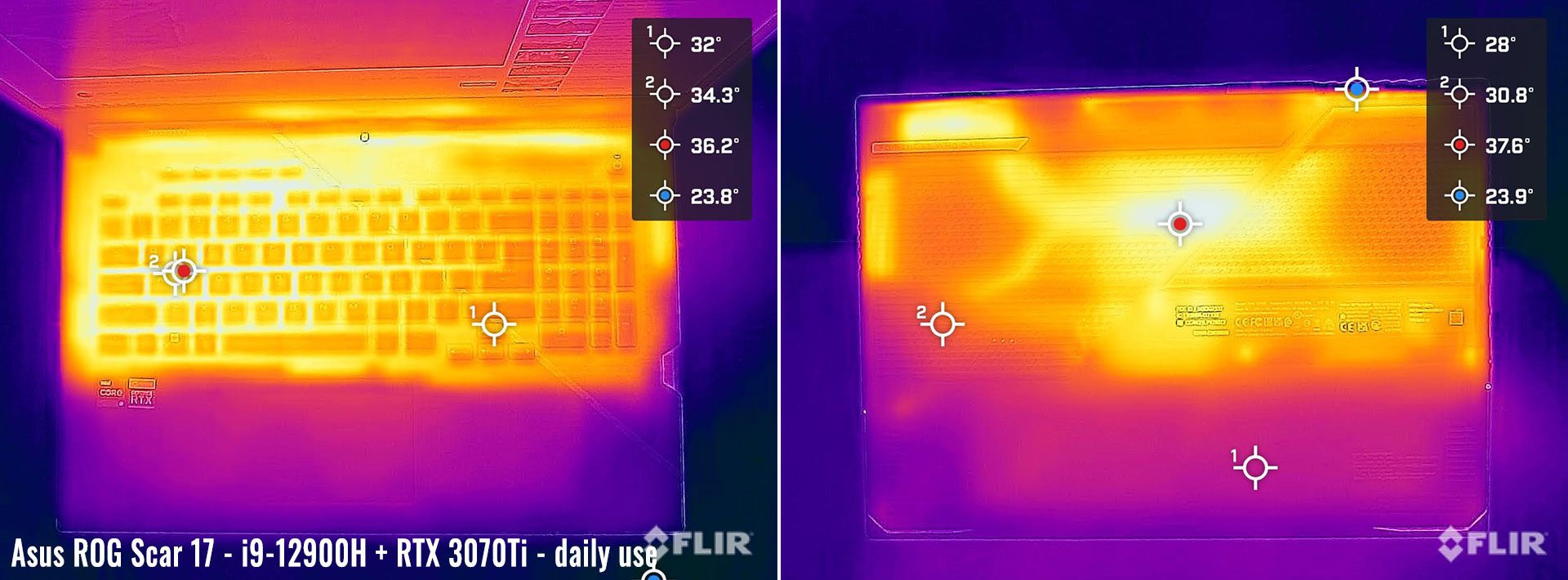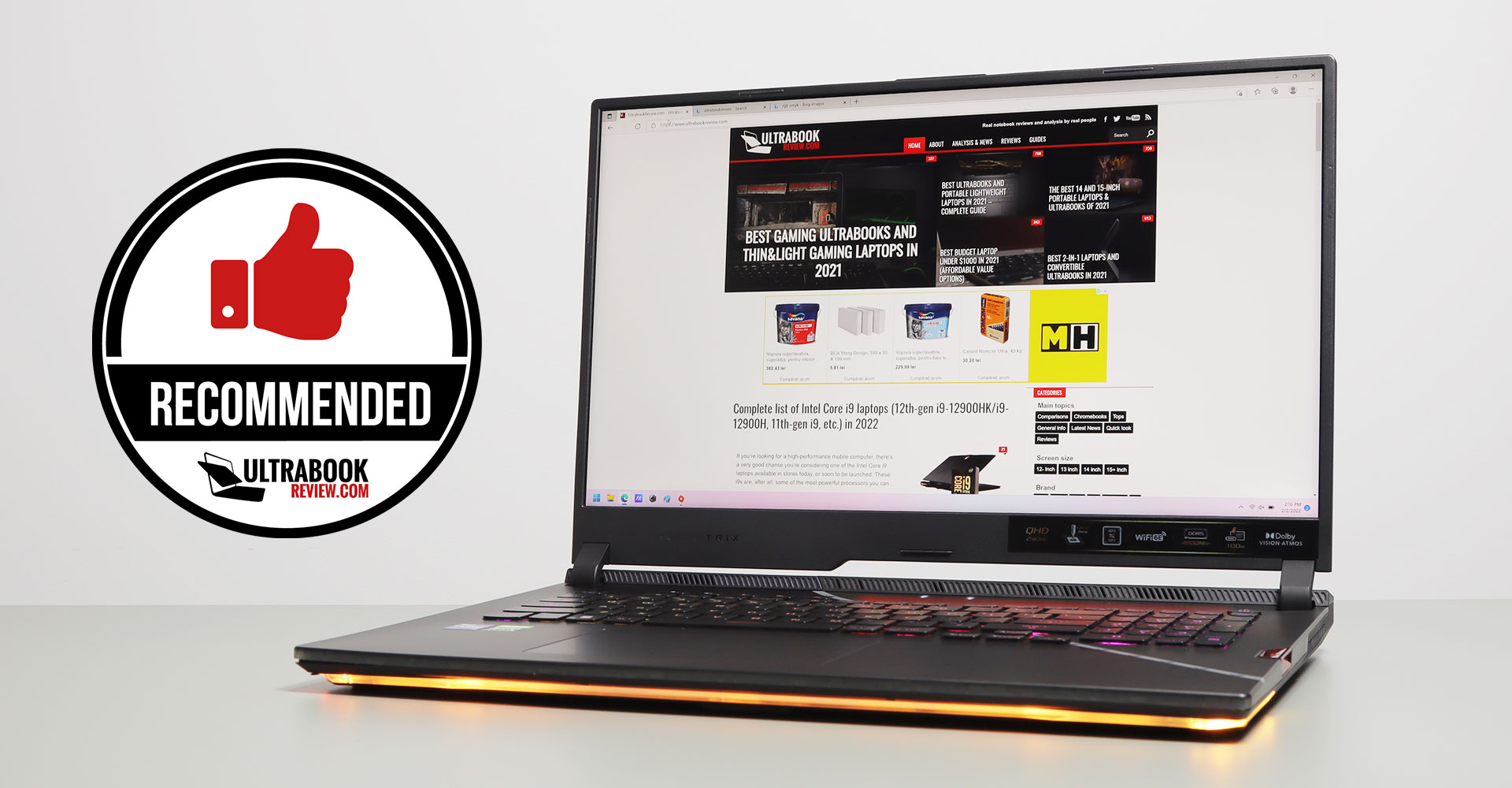
Asus ROG Strix SCAR 17 2022 review (G733ZW
This article is our detailed analysis of the 2022 Asus ROG Strix Scar 17, Asus’s full-size performance/gaming 17-inch laptop of this generation.
The 2022 model builds on the chassis and design lines of the previous Scar 17 from 2021, so don’t expect significant changes in looks or features. However, Asus rolled back on their optical-mechanical keyboard implemented on the 2021 model, which hasn’t been well received. The 2022 update now gets a more standard rubber-dome keyboard, which I prefer and expect most potential buyers to appreciate better.
Internally, the 2022 Scar switches over to an Intel 12th gen Alder Lake hardware platform, DDR5 memory, and the latest RTX 3000 Ti graphics chip from Nvidia, and Asus have also implemented a MUX on this generation and updated the power settings, allowing the GPUs to run at up to 150W now, up from the 130W limit on the 2021 generation.
All these translate into a significant performance boost in demanding workloads and games, but also high internal temperatures on the GPU side with those activities. That’s one of the downsides of this 2022 Scar 17 notebook, alongside the somewhat limited runtimes on battery.
We’ll get in-depth on all the essential details that you should be aware of before jumping on this series in the comprehensive review down below.
Specs sheet as reviewed
| 2022 ASUS ROG Strix SCAR 17 G733ZW | |
| Display | 17.3-inch, 16:9, non-touch, matte, BOE BOE0A69 panel QHD 2560 x 1440 px IPS, 240 Hz with 100% DCI-P3 FHD 360Hz panel option also available, with 100% SRGB |
| Processor | Intel 12th gen Alder Lake, up to Core i9-12900H, 6C+8c/20T |
| Video | Intel UHD + Nvidia GeForce RTX 3080Ti Laptop 16GB (up to 150W with Dynamic Boost) with MUX and Adaptive Sync (no GSync on internal display) |
| Memory | 32 GB DDR5-4800 RAM – up to 64 GB (2x DIMMs) |
| Storage | 2 TB SSD (Samsung PM9A1) – 2x M.2 PCI 4.0 x4 slots |
| Connectivity | WiFi 6E (Mediatek MT7922) 2×2 with Bluetooth 5.2, 2.5Gigabit LAN (Realtek RTL8125) |
| Ports | 2x USB-A 3.2 gen1, 1x USB-C with Thunderbolt 4, 1x USB-C gen2 with video and data, HDMI 2.1, LAN, headphone&mic |
| Battery | 90Wh, 280 W power adapter, USB-C charging up to 100W |
| Size | 395 mm or 15.55” (w) x 282 mm or 11.1 (d) x 27.5 mm or 1.08” (h) |
| Weight | 2.76 kg (6.1 lbs), .99 kg (2.2 lbs) power brick and cables, EU version |
| Extras | rubber-dome per-key RGB backlit keyboard with NumPad, quad speakers, no webcam or biometrics, Keystone |
Specs-wise, this is the best-value 2022 Scar 17 configurations available here, pairing the Core i9 processor with the RTX 3070Ti graphics chip and the QHD 240Hz screen. However, there’s a fair chance this particular combo might not be available everywhere, though, as Asus might reserve the QHD screen option only for the 3080/3080Ti configurations in some markets.
We’ll follow up with reviews on other GPU configurations in the next couple of weeks, for the top-tier RTX 3080Ti model (Scar 17 G733ZX) and hopefully for the base-tier RTX 3060 (Scar 17 RTX G733ZM) model as well.
Design and construction
The ROG Scar 17 is a full-size 17-inch laptop, roughly 1.1-inches (27 mm) thick and 6.1 lbs (2.76 Kg) in weight. It’s still relatively compact and lightweight for what it is, but it’s not by any means designed primarily as an ultraportable chassis; instead, it’s rather a balanced package of size, features, and performance.
On the outside, the 2022 SCAR 17 is nearly a perfect replica of the 2021 model, with only some minor design changes and a more subtly lit ROG logo.
Before, the entire lid-logo was backlit, and now only the perimeter is lit and the inside of the logo is not – this is still RGB and fully controllable in the Aura Creator control app, much like all the lightbars, the one under the display and the one around the main chassis. I still find the Aura app a bit cumbersome to figure out, but Asus includes a practical how-to guide that explains it well, and it eventually does what it’s designed to.
For the materials, aluminum is used for the lid-cover and different types of plastic for everything else. All of these are black or dark-gray and will show smudges easily, especially the smooth plastic on the arm-rest and the anodized metal on the lid. This means you’ll constantly need to clean this if you like your laptop neat.
Some of you might also complain about the inner chassis being made out of plastic and not metal, but this actually feels comfortable to the touch. Plus, on the esthetics side, the top-right half of the C-deck is translucent and allows you to peek inside at the internal components, something that would not have been possible with a metal deck. This is a design particularity of the ROG Scar series, alongside the customizable ROG caps, with a couple of different versions included in the pack and the ability to create your own 3D printed versions if you want to customize your laptop.
That aside, the build quality is sturdy, with little flex in either the lid, chassis, or keyboard desk. I also haven’t noticed any warping or squeaky noises during my time with any of the 2022 ROG Strix models.
The practicality of this design is a hit and miss, though. On the positive side, the laptop sits very well anchored on the desk thanks to its grippy rubber feet, the screen can be easily pulled up and adjusted with a single hand, and the edges are dulled and friendly on the wrists. There’s also a very spacious arm-rest on this laptop, as expected from a 17-inch product, uncompromised inputs, and punchy speakers, some of them firing through cuts under the display.
On the other hand, the screen still doesn’t lean back past 110 degrees, which can be limiting when not using this computer on a desk. Some might also complain about the design, with tiny bezels at the top and on the sides of the display (which leave no room for any camera), and a hefty chin underneath. This doesn’t bother me, but I would have preferred not having that cut in the chin that allows me to peek behind the laptop and see the cables connected back there.
What bothers me is that Asus didn’t do anything about the big and bright status LEDs that are placed just under the screen, or the always-on red light in the power button. I find both annoying when using the laptop at night.
As for the IO, that’s still mostly on the back of the laptop and on the left side, with the right reserved for the Keystone. As a novelty, there are only 2x USB-A slots now, both on the left edge, and 2x USB-C ports on the back: one of them supports Thunderbolt 4 with data and video and is plugged into the iGPU, and the other supports data and video through the dGPU. In addition, the HDMI 2.1 port also goes into the dGPU now, so both of these can be used to output games to an external monitor without sacrificing performance.
I still don’t understand the practical benefits of that Keystone and would have preferred if Asus had utilized that space for either an SD card reader or even an extra USB-A slot. This might not sound like much, but having all the USB-As on the left isn’t ideal to me, although it is something I can live with.
All in all, the ROG Scar 17 is still a fair design for 2022, and it would be up to you to accept its drawbacks or look elsewhere if any are a deal-breaker.
Keyboard and trackpad
Asus rolled back to a standard rubber-dome keyboard on the 2022 ROG Scar 17, after last year’s experiment with the optomechanical switches wasn’t received as well as they were expecting.
I was among those who complained about the clicky mechanical keys and I’m happy they came back to a regular keyboard this year, which feels to me more comfortable to use and is also far quieter.
The layout is also partially different, especially around the arrows and NumPad section. Yes, the NumPad area is a bit more cramped than the other keys, but there’s a key for almost everything in there. And while the arrows are shorter than on the 2021 design, I still find them perfectly usable and I appreciate how they’re slightly spaced out from everything else.
As far as the typing experience goes, to me, this is an average keyboard very similar to the one in the 2021 ROG Strix G17 series. It didn’t strike me for anything in particular, it just does what it’s meant to do.
The keys are also RGB backlit, with per-key control and various effects selectable in Armoury Crate and Aura Creator app. The LEDs are bright enough and uniform, with some light creeping from underneath the keycaps, but not noticeably or annoyingly.
For mouse, Asus kept the larger glass clickpad they offered in the past. It’s spacious, smooth to the touch, and accurate, but I still find the physical clicks to be rather clunky, and I noticed that the surface rattles with firmer taps. So tap it gently.
As for biometrics, there are still none on this 2022 ROG Strix SCAR 17.
Screen
Asus offers two screen options for this 2022 ROG Scar 17, all 17.3-inch, 16:9, matte and non-touch:
- FHD 360Hz 3ms with 300+ nits of brightness and 100% sRGB colors;
- QHD 240Hz 3ms with 300+ nits of brightness and 100% DCI-P3 colors.
We have the latter option on our unit and the one that makes the most sense on this kind of laptop today.
Aside from the fact that this panel doesn’t get very bright, there’s nothing to complain about. This screen option is ideal for daily use, gaming, and professional creators who need good color accuracy and gamut coverage. Still, if there’s one more thing missing here: GSync support on the internal monitor; Adaptive Sync is implemented instead to prevent tearing.
Here’s what we got in our tests, with an X-Rite i1 Display Pro sensor:
- Panel HardwareID: BOE BOE0A69 (NE173QHM-NZ2);
- Coverage: 99.9% sRGB, 85.0% AdobeRGB, 99.2% DCI-P3;
- Measured gamma: 2.15;
- Max brightness in the middle of the screen: 299.47 cd/m2 on power;
- Min brightness in the middle of the screen: 12.44 cd/m2 on power;
- Contrast at max brightness: 1115:1;
- White point: 6900 K;
- Black on max brightness: 0.26 cd/m2;
- PWM: No.
The panel comes well calibrated out of the box, yet you can further improve the Gamma and White Point with a calibration run. Once calibrated, our sample proved reasonably uniform, yet with some imbalances in the corners and some noticeable light bleeding – the luck of the draw, and I expect these to vary between each unit, so make sure to properly look into them when you get your units.
A FHD 360Hz panel is also an option with the lower tier configurations of this laptop, and it’s similar to the panel we tested in the 2021 Scar 17 over here. That’s still a fair quality panel, just not as color-rich and lower-resolution.
Hardware and performance
Our test model is a higher-specced configuration of the ASUS ROG Strix Scar 17, code name G733ZW, built on an Intel Core i9-12900H processor, 32 GB of DDR5-4800 memory in dual channel, 2 TB of fast SSD storage, and dual graphics: the Nvidia RTX 3070Ti dGPU with 8 GB of vRAM and the Iris Xe iGPU integrated within the Intel processor.
Before we proceed, keep in mind that our review unit was sent over by Asus and it runs on the early software available as of early-February 2022 (BIOS 306, Armoury Crate 5.0.22.0, GeForce 511.65 drivers). Some aspects might change with later software.
Spec-wise, this 2022 ASUS ROG Scar 17 is built on the latest Intel and Nvidia hardware available to date. The Core i9-12900H is one of the top mobile processors in Intel’s Alder Lake 12th-gen platform, with 14 Cores and 20 Threads. It is a hybrid design with 6High Performance and dual-threaded Cores, and 8 extra Efficiency cores, which works together in the various loads. The design and thermal module of this Scar also allow the processor to run at up to 100W of sustained power in demanding CPU loads, on the maximum-performance profile.
For the GPU, the 2022 Scar 17 series is available with RTX and RTX graphics chips. What we have on this sample is the mid-tier RTX 3070Ti running at up to 150W with Dynamic Boost in supported games and applications. Compared to last year’s Scar series, Asus bumped the power settings of the GPU, updated the thermal compound used for heat transfer, and also added a MUX to the design, all these leading to a noticeable increase in performance.
As for the RAM and storage options, the laptop still comes with two accessible memory DIMMs and two M.2 SSD slots. Our unit shipped with 32 GB of DDR5-4800 RAM in dual-channel and a Fast PCIe 4.0 Samsung SSD. I cannot guarantee you’ll get the exact same SSD with the retail units.
Getting inside to the components is a basic task, you just have to pop up the back panel, held in place by a couple of Philips screws. Be extra careful when you lift up the bottom panel as it’s attached to the mainboard by two ribbons that power the LED strips on the front. Pulling too hard might cause those to disconnect, in which case you’ll need to reslot their connectors in their place.
Inside you’ll find all the components, the big battery, and the thermal module. There’s still a fair bit of unused space, though, and that’s because Asus implements the same design between the Scar 17 and the smaller Scar 15, with only longer heatpipes on the GPU side for the 17-inch model. I would have appreciated that extra space to be put to some use, perhaps for a more significant GPU radiator/fan or beefier speakers in that empty space around the battery.
Specs aside, Asus offer their standard four power profiles in the Armoury Crate control app: Silent, Performance, Turbo and Manual, with various power settings and fan profiles between them:
- Silent – quite fan-noise at under 35 dB, limited CPU/GPU speeds and power;
- Performance – balanced profile with stock CPU/GPU settings and 40 dB max fan noise;
- Turbo – High-Performance profile with increased CPU power allocation, faster-spinning fans at up to 48 dB, and overclocked GPU (+50 MHz Core/+100 MHz Memory, up to 150W,).
- Manual – like Turbo, but with the ability to custom tweak the CPU PL1/PL2 power level and GPU power/clocks, plus create manual fan profiles based on temperature limits.
Turbo/Manual are only available with the laptop plugged in and are meant for gaming and other demanding loads. Performance is a jack-of-all-trades, while Silent is made for light daily use. The system is able to idle the fans on the Silent profile as long as the CPU/GPU stay under 60 degrees C, leading to a quiet daily-use experience.
Here’s what to expect in terms of performance and temperatures with everyday multitasking, browsing, and video.
Performance and benchmarks
On to more demanding loads, we start by testing the CPU’s performance by running the Cinebench R15 test for 15+ times in a loop, with a 1-2 seconds delay between each run.
The Core i9 processor stabilizes at ~100W of sustained power on the Turbo setting, which translates in frequencies of 3.3+ GHz on the P Cores, temperatures in the 93-95 C, scores of ~2700 points. The fans spin at around 48 dB at head-level in this mode. The CPU does run at higher power for a short while in this test, as the PL1 and PL2 levels are set at 135W here, but thermal and power throttling kick in after a little bit, leading to the stabilized sustained power of around 100W.
That means the i9 processor could score somewhat higher in this test in a different thermal design. At the same time, the 2022 i9-based Scar 17 scores roughly 25% higher in this test compared to the 2021 Ryzen 9 Scar 17. It’s also worth noting that Asus have also upped the sustained power limits from the Ryzen 9 2021 models by a fair amount, as those were only running at 75-80W sustained power.
For what is worth, there’s no undervolting option in the BIOS, and voltage control is locked with both XTU and Throttlestop, so there’s no way to tweak the CPU at this point.
Switching over to the Performance profile translates in the CPU stabilizing at 70W and temperatures still in the mid 90s, but with the fans spinning quieter at ~40 dB at head-level. Once more, the system allows for a higher power allocation closer to the 90W PL1 limit set for this profile for a couple of loops, and then the PL2 power limit kicks in once the processor hits 95C consistently.
The Silent profile is more aggressively power-limited at only 30W sustained, with barely audible fans (sub 35 dB) and middling temperatures (high-60s C). The i9-12900H still scores 1500 points in the Cinebench test, roughly 60% of the Turbo performance, and still fairly respectable for a Silent mode.
Finally, the CPU runs at ~35 W on battery, on the Performance profile, with still respectable scores of around 1650+ points. Details below.
To put thee in perspective, here’s how this Core i9-12900H implementation fares against other full-size implementations in this test, both Intel and AMD. It simply tops our chart by a significant margin over anything else. We haven’t yet tested the 2022 Ryzen 6900HX to see how that fares against the i9.
We also ran the 3DMark CPU profile test. Take the results for what they are, as this is our first Alder Lake review unit. Once more, on Turbo the results are 5%+ over anything else in lower-cores tests, and 20+% over the competition in the 16 and all-threads test.
We then went ahead and further verified our findings with the more taxing Cinebench R23 loop test and Blender – Classroom, which result in similar findings to what we explained above.
Finally, we ran our combined CPU+GPU stress tests on this notebook. 3DMark stress runs the same test for 20 times in a loop and looks for performance variation and degradation over time, and this unit passed it just fine, which means there’s no performance throttling with longer-duration sustained loads.
Next, we ran the entire suite of tests and benchmarks, on the stock Turbo profile in Armoury Crate.
- 3DMark 13 – Fire Strike: 26461 (Graphics – 29768, Physics – 31403, Combined – 12789);
- 3DMark 13 – Port Royal: 6856;
- 3DMark 13 – Time Spy: 11646 (Graphics – 11302, CPU – 14081);
- Uniengine Superposition – 1080p Extreme: 7132;
- Uniengine Superposition – 1080p Medium: 21075;
- Handbrake 1.3.3 (4K to 1080p encode): 67.19 average fps;
- PassMark 10: Rating: 9888 (CPU mark: 33280, 3D Graphics Mark: 23838, Disk Mark: 39791);
- PCMark 10: 7825 (Essentials – 10841, Productivity – 9752, Digital Content Creation – 12298);
- GeekBench 5.4.3 64-bit: Single-Core: 1865, Multi-core: 13833;
- CineBench R15 (best run): CPU 2933 cb, CPU Single Core 264 cb;
- CineBench R20 (best run): CPU 7102 cb, CPU Single Core 708 cb;
- CineBench R23 (best run): CPU 18506 cb, CPU Single Core 1838 cb;
- x265 HD Benchmark 64-bit: 48.78 s.
Compared to the R9 + RTX 3080 Super 130W configuration of the 2021 Scar 17, the 2022 i9 + RTX 3070Ti 150W+ MUX model ends up faster across the board.
On the CPU side, we’re looking at 15-25% higher scores in the single-core loads and 20-30% higher in the all-core tests.
On the GPU side, the RTX 3080 in the 2021 Scar only came up faster in the RTX tests, but the higher-power RTX 3070Ti in the 2022 generation outscores it by a small margin in all the other benchmarks. That’s impressive considering the 3070Ti is a lower-priced chip, and that Asus also offers a 3080 and a 3080Ti for the 2022 Scar 17 for those interested in the best possible GPU performance in this chassis. However, the best-value for your money is most likely in these 3070 configurations.
And here are some workstation benchmarks, on the same Turbo profile:
- Blender 2.93 – BMW Car scene- CPU Compute: 2m 21s (Turbo);
- Blender 2.93 – BMW Car scene- GPU Compute: 35s (CUDA), 19s (Optix);
- Blender 2.93 – Classroom scene – CPU Compute: 6m 35s (Turbo);
- Blender 2.93 – Classroom scene – GPU Compute: 2m 24s (CUDA), 1m 2s (Optix);
- Pugetbench – DaVinvi Resolve: 1193 points;
- Pugetbench – Adobe Afert Effects: 1021;
- Pugetbench – Adobe Photoshop: 1141;
- Pugetbench – Adobe Premiere: 919;
- SPECviewperf 2020 – 3DSMax: 158.49 (Turbo);
- SPECviewperf 2020 – Catia: 70.88 (Turbo);
- SPECviewperf 2020 – Creo: 104.91 (Turbo);
- SPECviewperf 2020 – Energy: 32.54 (Turbo);
- SPECviewperf 2020 – Maya: 398.47 (Turbo);
- SPECviewperf 2020 – Medical: 33.4 (Turbo);
- SPECviewperf 2020 – SNX: 22.32 (Turbo);
- SPECviewperf 2020 – SW: 256.53 (Turbo).
- V-Ray Benchmark: CPU – 12454 vsamples, GPU CUDA – 1250 vpaths, GPU RTX – 1541 vpaths;
The i9 demolishes the Ryzen 9 5900HX in the 2021 Scar 17 Blender, and as a whole this middle-upper 2022 configuration outmatches the 2021 top-tier model across the board in all the activities and applications, by a smaller or greater amount.
Now, all these are excellent results, but you might also consider that the laptop does run at up to 48 dB on the Turbo profile, so there might be situations when you’d rather sacrifice the performance to some extent as long as you can keep the fans quieter. Here’s how this 2022 Scar 17performs on the Performance profile, which limits the fans to around 40 dB at head level.
- 3DMark 13 – Fire Strike: 23573 (Graphics – 27288, Physics – 28940, Combined – 10253);
- 3DMark 13 – Time Spy: 10660 (Graphics – 10368, CPU – 12691);
- Uniengine Superposition – 1080p Extreme: 6712;
- CineBench R20 (best run): CPU 6224 cb, CPU Single Core 704 cb.
The performance only takes a ~10% hit on this mode, but at the same time the internals tend to heat up a fair bit in this case. That means I wouldn’t abuse of this Performance mode for sustained demanding chores, especially when using the laptop in a hotter environment.
You can also opt for the Silent profile, in which case the fans rarely go over 35 dB. Here’s what we got in this case:
- 3DMark 13 – Fire Strike: 9756 (Graphics – 10809, Physics – 18815, Combined – 3978);
- 3DMark 13 – Time Spy: 4751 (Graphics – 4310, CPU – 11309);
- Uniengine Superposition – 1080p Extreme: 3690;
- CineBench R20 (best run): CPU 3749 cb, CPU Single Core 594 cb.
The CPU and especially the GPU end up significantly limited in this mode, but they also run at perfectly adequate temperatures, so there are no thermal restrictions to using this Scar 17 on Silent. Up to you if the performance/noise equilibrium is justifiable for you on this Silent profile.
Gaming performance
Now, the ROG Scar 17 is primarily a gaming laptop, so let’s see how it handles modern titles.
We tested several games at QHD and FHD resolution on Ultra settings, on the stock Turbo and Performance profiles, but also on a Manual mode that I’ll explain further down. I haven’t included Silent mode in the tables, but we’ll also discuss it down below.
Here are the raw numbers, all these on the Discrete GPU mode:
| Intel Core i9-12900H + RTX 3070Ti Laptop 125-150W |
QHD Turbo | QHD Manual | QHD Performance | FHD Turbo |
| Battlefield V (DX 12, Ultra Preset, RTX OFF) |
124 fps (65 fps – 1% low) | 128 fps (70 fps – 1% low) | 115 fps (48 fps – 1% low) | 160 fps (58 fps – 1% low) |
| Cyberpunk 2077 (DX 12, Ultra Preset, RTX OFF) |
44 fps (35 fps – 1% low) | – | 41 fps (32 fps – 1% low) | 66 fps (53 fps – 1% low) |
| Far Cry 6 (DX 12, Ultra Preset) |
85 fps (45 fps – 1% low) | 87 fps (46 fps – 1% low) | 77 fps (40 fps – 1% low) | 105 fps (55 fps – 1% low) |
| Far Cry 5 (DX 11, Ultra Preset, SMAA) |
111 fps (86 fps – 1% low) | 114 fps (88 fps – 1% low) | 102 fps (76 fps – 1% low) | 153 fps (111 fps – 1% low) |
| Metro Exodus (DX 12, Ultra Preset, RTX OFF) |
67 fps (48 fps – 1% low) | – | 62 fps (46 fps – 1% low) | 84 fps (54 fps – 1% low) |
| Red Dead Redemption 2 (DX 12, Ultra Optimized, TAA) |
79 fps (54 fps – 1% low) | – | – | 115 fps (88 fps – 1% low) |
| Shadow of Tomb Raider (DX 12, Highest Preset, TAA) |
99 fps (59 fps – 1% low) | 100 fps (64 fps – 1% low) | 91 fps (55 fps – 1% low) | 133 fps (72 fps – 1% low) |
| Doom Eternal (Vulkan, Ultra Preset) |
164 fps (91 fps – 1% low) | – | 161 fps (84 fps – 1% low) | 278 fps (86 fps – 1% low) |
| The Witcher 3: Wild Hunt (DX 11, Ultra Preset, Hairworks On 4) |
106 fps (79 fps – 1% low) | 108 fps (82 fps – 1% low) | 100 fps (74 fps – 1% low) | 143 fps (101 fps – 1% low) |
- Battlefield V, The Witcher 3 – recorded with Fraps/in-game FPS counter in campaign mode;
- Far Cry 5, Middle Earth, Strange Brigade, Red Dead Redemption 2, Tomb Raider games – recorded with the included Benchmark utilities;
- Red Dead Redemption 2 Optimized profile based on these settings.
Those above are rasterization tests, and here are some results for RTX titles.
| Intel Core i9-12900H + RTX 3070Ti Laptop 125-150W |
QHD Turbo | FHD Turbo |
| Battlefield V (DX 12, Ultra Preset, RTX ON, DLSS OFF) |
79 fps (61 fps – 1% low) | 106 fps (74 fps – 1% low) |
| Dune: Eternal (DX 12, Ultra Preset, RTX ON, DLSS OFF) |
113 fps (73 fps – 1% low) | 244 fps (82 fps – 1% low) |
| Cyberpunk 2077 (DX 12, Ultra Preset + RTX, DLSS Quality) |
51 fps (42 fps – 1% low) | 62 fps (51 fps – 1% low) |
| Shadow of Tomb Raider (DX 12, Highest Preset, TAA, RTX Ultra) |
58 fps (28 fps – 1% low) | 84 fps (36 fps – 1% low) |
Compared to the 2021 Scar 17, the 2022 model implements a higher-power GPU, a MUX, and an improved thermal compound on the CPU. All these lead to a 5-12% increase in framerates when comparing this 3070Ti in the 2022 model to the higher-tier 3080 chip in the 2021 Scar 17.
MUX performance – Hybrid vs Discrete modes
I was curious to measure the impact that the MUX has on the 2022 model, and here’s a comparison between the Hybrid and dGPU modes.
| Intel Core i9-12900H + RTX 3070Ti Laptop 125-150W |
QHD Turbo, dGPU | QHD Turbo, Hybrid | FHD Turbo, dGPU | FHD Turbo, Hybrid |
| Battlefield V (DX 12, Ultra Preset, RTX OFF) |
124 fps (65 fps – 1% low) | 123 fps (64 fps – 1% low) | 160 fps (58 fps – 1% low) | 154 fps (56 fps – 1% low) |
| Far Cry 6 (DX 12, Ultra Preset) |
85 fps (45 fps – 1% low) | 78 fps (61 fps – 1% low) | 105 fps (55 fps – 1% low) | 99 fps (66 fps – 1% low) |
| Far Cry 5 (DX 11, Ultra Preset, SMAA) |
111 fps (86 fps – 1% low) | 110 fps (88 fps – 1% low) | 153 fps (111 fps – 1% low) | 148 fps (109 fps – 1% low) |
| Metro Exodus (DX 12, Ultra Preset, RTX OFF) |
67 fps (48 fps – 1% low) | 66 fps (48 fps – 1% low) | 84 fps (54 fps – 1% low) | 83 fps (52 fps – 1% low) |
| Shadow of Tomb Raider (DX 12, Highest Preset, TAA) |
99 fps (59 fps – 1% low) | 97 fps (82 fps – 1% low) | 133 fps (72 fps – 1% low) | 125 fps (67 fps – 1% low) |
| Doom Eternal (Vulkan, Ultra Preset) |
164 fps (91 fps – 1% low) | 153 fps (62 fps – 1% low) | 278 fps (86 fps – 1% low) | 228 fps (76 fps – 1% low) |
| The Witcher 3: Wild Hunt (DX 11, Ultra Preset, Hairworks On 4) |
106 fps (79 fps – 1% low) | 108 fps (80 fps – 1% low) | 143 fps (101 fps – 1% low) | 140 fps (85 fps – 1% low) |
The results vary between the different titles, but we can argue that you can run most titles on the Hybrid mode just fine, especially when it comes to the recent AAA titles at QHD resolution. The MUX plays a bigger role at FHD resolution in high-framerate titles such as Doom or CS:Go.
With that out of the way, let’s go over some performance and temperatures logs.
For starters, here’s what happens on the Turbo profile, with an ambient room temperature of around 25 C.
With most games, the GPU runs in the 82-86 degrees Celsius in this case and close to the 150W of power allowed with Dynamic Boost 2.0. That’s hot and too close to the 87C thermal limit for my liking, as I prefer GPU temperatures under 80 C as much as possible for sustained gaming periods, which would leave some room for when the GPU paste degrades later on.
On the CPU side, I’ve recorded temperatures of around 80 degrees Celsius in most titles, as the system powers down the CPU to around 25-30W as it shifts the power to the GPU with Dynamic Boost. Far Cry 5 is the exception that allocated more power to the CPU, and in this case, we measured average CPU temperatures in the mid to high 80s on the i9 processor, with still similar ~85 C on the GPU.
Go through the logs for more details. This batch is at the screen’s native QHD resolution.
And these are also for the Turbo mode, but at FHD resolution.
We measured similar temperatures on the 2021 Scar 17, and with the various tricks tried last year in mind, I wanted to see what can be done to tame down the high GPU temperatures recorded on this 2022 Scar 17 as well.
First, I bumped up the back of the laptop from the desk, in order to improve the airflow into the fans, as the rear rubber feet are still rather slim and choke up the intakes to some amount.
The results vary between titles, but the logs indicate a 2-5 degrees C decrease in temperatures on both the CPU and GPU in all games, which translates in CPU temperatures in the 75-80 Celsius and GPU temperatures in the 80-83 Celsius. This might not seem like much, but it’s a notable improvement that Asus could have easily achieved with taller rubber feet on the back of the laptop.
Then I moved on to the Manual mode which allows customizing the fan profiles and CPU/GPU settings. You can push the fans to 100% if you want to, in which case you should expect noise levels in the 52-54 dB at head level, up from the 48 dB on the standard Turbo profile. I opted for some middle ground settings instead:
- CPU: PL1 limit at 35W (to prevent CPU overheating in titles that don’t scale well with Dynamic Boost and favor the power shifting to the GPU), fan set at 60% rpm for temperatures over 70C, 80% rpm for over 80C and 90% rpm for over 90C.
- GPU: the same +50MHz Core and +100 MHz memory overclock (there’s room for further tweaking here), fan set at 80% for temperatures over 75C and 90% for over 80C.
This profile pretty much pushes the GPU fan at 90% in most titles, and actually helps stabilize temperatures and performance in Far Cry 5, as shown in the tables above.
However, this manual profile has almost no noticeable impact over the CPU/GPU temperatures with the laptop sitting on a desk.
However, bumping the back of the laptop from the table helps once more, shaving off 1-2 extra degrees over the components compared to the raised Turbo mode.
One other aspect this Manual mode allows is to set a GPU thermal limit and the system will adjust the frequency and power to make sure the chip doesn’t go above that. For testing, I’ve set the limit at 80 degrees Celsius, and kept the laptop on the desk.
In Far Cry 6, this comes with a roughly 10% hit in performance, as the GPU drops to ~130W of average power. In Cyberpunk, the performance only drops by about 7%, as the GPU averages ~133W of power in this scenario.
Now, if you’re looking for quieter noise levels when running games, your options are either the Performance mode or the Silent mode.
On Performance, the rpms take a ~10% hit compared to the Turbo mode, while the components still run just as hot if not hotter, as the fans spin much quieter at 40 dB. You can play games fine on this profile, but you’ll have to accept GPU temperatures in the 85+ and GPU power throttling, as well as higher surface temperatures than on the Turbo mode.
Lifting up the back of the laptop helps, but not as much as on the Turbo profile, due to the lower fan rpms in this case.
However, you could create a Performance like profile in the Manual mode, opting for a lower Dynamic Boost setting, lower fan profiles, and a GPU temperature limit, which would allow a solid gaming experience at around 40 dB noise levels. Expect about a 15-25% performance toll over the Turbo profile, though. I’ll further look into this in our future Scar reviews.
The Silent mode aggressively limits the CPU and GPU, leading to component temperatures in the 60-70 C despite fan noise levels of sub 35 dB.
Most games are still going to run OK with Whisper Mode activated and a 60 fps limit, but you’re not getting 60 fps in the recent AAA titles at QHD resolution and Ultra settings, so you’ll need to trim down some of the graphics settings. I’d say QHD Medium should be OK on most games on this Silent profile, which is respectable considering the excellent temperatures and noise levels you’re getting here.
All in all, the 2022 Scar 17 is an excellent performer across the board. With the 12th gen i9 processor, the DDR5 memory, the higher-power graphics, and the MUX, you can expect a performance bump of 15-25% compared to the 2021 Scar 17, for matching specs.
At the same time, this laptop still runs hot internally, especially on the GPU side with this generation. Asus haven’t updated the thermal module or the thermal paste or the bottom rubber feet over the previous generation, despite the fact that they pushed the GPU 20W higher in power-draw with this series. Bumping the back of the laptop from the desk helps a fair bit here, and I’d also seriously consider a top cooling pad for serious gaming on this 2022 Scar 17, as well as further tweaking in the Manual mode.
Noise, Heat, Connectivity, speakers, and others
As mentioned already, Asus haven’t updated the thermal design of this 2022 Scar 17 in comparison to the previous 2021 generation.
The only notable difference is an updated liquid-metal compound used on the CPU side (Thermal Grizzly Conduconaut Extreme), which actually seems to help here in corroboration with the Dynamic Boost technology that shifts power from the CPU to the GPU in sustained applications, as this 2022 Scar 17 is able to run the CPU at higher sustained power than the previous Scar 17 could for the AMD processor, and the overall CPU temperatures in combined loads are also noticeably lower for this 2022 generation.
The GPU does run hot, though, at 82-87 Celsius on the Performance and Turbo profiles in all the tested games, with the laptop sitting on the desk, and that’s despite the fact that Asus actually updated the fan settings allowing them to run faster on Turbo than on the 2021 generation. The laptop takes most of the fresh air from the bottom, where the intakes are somewhat choked by the slim rubber feet that Asus implement on this series. As a result, bumping up the back of the laptop leads to a noticeable decrease in those internal temperatures, both on the CPU and especially on the GPU side.
To me, this is no surprise given our experience with the 2021 Scar design and the higher-power settings on this 2022 model. Ideally, Asus should have opted for those higher rear rubber feet, but also should have updated the internal cooling on the GPU side, perhaps implementing a larger radiator, a higher-capacity fan, and even an extra heatpipe in the space that’s now left unused. They didn’t, as they still share the same design between the Scar 15 and Scar 17 for coast-cutting reasons, with only slightly longer heatpipes on the 17-inch chassis.
With those changes, the GPU could have run cooler and perhaps Asus could have also allowed for even higher GPU power, closer to the 165+W that the competition offer on their full-size 17-inch chassis, such as the Alienware X17, the GE76 Raider or even an updated Predator Helios 500 when/if available. As it is, the Scar 17 comes within 90-95% of the performance of those options, which is something I can accept considering the more affordable price tag with this series, but it also ends up running too hot on the GPU side, which is harder to accept on this kind of a notebook that’s primarily created for heavy gaming.
Now, as far as the outer case temperatures go, those are alright on Turbo and only noticeably warmer on the Performance and Silent profile.
*Gaming – Silent – playing Far Cry 5 for 30 minutes, Silent profile, fans at ~35 dB
*Gaming – Performance – playing Far Cry 5 for 30 minutes, fans at ~40 dB
*Gaming – Turbo, on desk – playing Cyberpunk 2077 for 30 minutes, fans at ~48 dB
At the same time, gaming aside, this laptop is a breeze with everyday use, with multitasking, browsing, or video streaming. The 0dB Technology allows the two fans to completely switch off with light use on the Silent profile, as long as the hardware stays under 60 C, which is most of the time. And that’s both on battery or when plugged in.
*Daily Use – streaming Netflix in EDGE for 30 minutes, Silent profile, fans at 0 dB
For connectivity, there’s Wireless 6E and Bluetooth 5 on this unit, as well as 2.5 Gigabit Lan, an update from the previous generations. However, Asus only equipped our sample with a rather limited Mediatek chip, which is OK for everyday use, but not as fast as the modern Intel wireless modules available these days. I can’t tell for sure what you’ll be getting on the retail units – this is probably due to the current chip shortage, and something that will hopefully change in the future. As far as I can tell, the WiFi chip can be updated if you need/want to and you can find a compatible upgrade.
The audio quality here is very good for laptop speakers, with two main speakers firing on the bottom and extra tweeters firing through the grills under the display, between the hinges. The sound is rich and with fair bass, as well as loud at 80+ dB at head-level. I haven’t noticed any distortions at high levels, but the arm-rest tends to vibrate noticeably, so you might want to use headphones for your games if this is something that would bother you. As far as I can tell, Asus didn’t skimp on the headphone output here.
Finally, the camera… well, there still isn’t any.
Battery life
There’s a 90Wh battery inside all the 2022 ROG Scar models, both the 15 and 17-inch options, just like in the 2021 models.
The system is also set to automatically switch the screen’s refresh to 60 Hz when using the laptop on battery, to increase efficiency, so if you’ll notice a quick screen flicker when you disconnect the laptop from the wall, that’s a side-effect of this tweak. Also, if you’re looking to maximize runtimes, make sure you’re using the laptop in the Hybrid mode and not on the discrete GPU profile in Armory Crate.
Here’s what we got on our review unit in terms of battery life, with the screen’s brightness set at around 120 nits (~60 brightness) and on Hybrid mode.
- 18 W (~5 h of use) – text editing in Google Drive, Silent Mode, screen at 60%, WiFi ON;
- 17 W (~5 h of use) – 1080p fullscreen video on Youtube in Edge, Silent Mode, screen at 60%, WiFi ON;
- 15 W (~5-6 h of use) – Netflix fullscreen in Edge, Silent Mode, screen at 60%, WiFi ON;
- 24 W (~3-4 h of use) – browsing in Edge, Performance Mode, screen at 60%, WiFi ON;
- 80 W (~1+ h of use) – Gaming – Witcher 3, Performance Mode, screen at 60%, WiFi ON, no fps limit.
This is not much, but there’s a chance the runtimes will improve with later software tweaks, as we’re testing an early sample here with early software. For what is worth, Asus mentions 10+ hours of video playback on their site, but we’re far from it in our tests.
So look for updates in later reviews, but don’t expect wonders. Given our experience with other Alder Lake laptops, it seems that efficiency is still the platform’s Achilles heel, despite the hybrid CPU design with the Efficiency cores.
In comparison, here’s what we got on last year’s AMD-based Scar 17.
- 11.5 W (~6-8 h of use) – text editing in Google Drive, Silent Mode, screen at 60%, WiFi ON;
- 8.5 W (~10+ h of use) – 1080p fullscreen video on Youtube in Edge, Silent Mode, screen at 60%, WiFi ON;
- 8 W (~10+ h of use) – Netflix fullscreen in Edge, Silent Mode, screen at 60%, WiFi ON;
- 14.5 W (~5-6 h of use) – browsing in Edge, Performance Mode, screen at 60%, WiFi ON;
- 80 W (~1+ h of use) – Gaming – Witcher 3, Performance Mode, screen at 60%, WiFi ON, no fps limit.
I’ll also add that this ROG Scar 17 G733ZW configuration comes with a 280W power brick, larger and heavier than the 240W variant on the 2021 Scars. The battery fills up in about 2 hours, with fast charging for the first half an hour, and USB-C charging is supported, up to 100W.
You won’t be able to use the laptop on Turbo/Manual while hooked over USB-C, but that’s enough for everyday multitasking and occasional heavy workloads on Performance, in case you don’t want to bring along the heavier main brick when on the go. The USB-C charger is not included in the box with this model, but Asus says you will be able to find a ROG branded 100W PD charger in most stores this year.
Price and availability- 2022 ASUS ROG Strix SCAR 17
The 2022 Asus ROG Scar 17 is listed in some regions at the time of this article.
The top-tier Scar 17 G733ZX, with the RTX 3080Ti dGPU, starts from ~$3100 in the US and 3299 EUR in Germany.
I’d expect the 3070Ti model tested here to go for a fair bit less, somewhere around $2500 in the US, as it’s already listed at 2799 EUR in Germany – but with the FHD screen, not the QHD that I would recommend. We’ll update once we know more.
Update: The same 3070Ti + FHD 360Hz screen configuration is available at $2299 from select retailers in the US. Not bad!
Follow this link for updated configurations and prices in your region at the time you’re reading this article.
Final thoughts- 2022 ASUS ROG Strix SCAR 17 review
Last year I ended up recommending the ROG Scar 17 as a well-balanced 17-inch performance/gaming laptop, but warned you about its mechanical keyboard and the high CPU/GPU temperatures under load.
This year, the 2022 Scar 17 gets updated hardware, higher power graphics, and a MUX, which translate into a significant increase in its capabilities. To put it simply, this year’s mid-range configuration outmatches last year’s top-tier model pretty much across the board, with the sole exception of some RayTracing benchmarks and games.
Furthermore, Asus opted for a more traditional rubber-dome keyboard, the kind offered with ROG laptops of the past. That optomechanical keyboard on the 2021 Scar 17 sure sounded interesting on paper, but I wasn’t a fan of its feedback and clickiness with actual use, despite the fact that I’m using a mechanical keyboard with my PC. So I’m glad they rolled back to a standard keyboard now.
All in all, the 2022 Scar 17 is a more capable performer and a better-value gaming laptop, especially in the mid-range RTX 3070/3070Ti configuration. You can still opt for the 3080s if you want to, but that’s not where your money would be best spent, especially considering the 150W GPUs in this product are not as fast as some other full-sized 17-inch laptops offer these days.
As far as my complaints go, there are still practical aspects that I wish Asus would have addressed, such as those annoying status LEDs and the rather weird IO placement that reserves the left-side entirely to what I consider a rather gimmicky and useless Keystone. That aside, there are still no biometrics on this laptop and no camera, and the interior smudges easier than pretty much any other laptop in this segment, so you’ll constantly have to run this clean.
The laptop’s thermal design is one other aspect to mention here. Last year, the Scar 17 ran hot especially on the CPU side, and this year Asus seem to have addressed that issue, but ended up with very high GPU temperatures on most profiles, close and even over 85C sustained. That shouldn’t have been a surprise when they upped the power settings to 150W without changing the internal cooling module in any way and without improving the intakes into the fans, which are still choked by the slim rubber feet.
As a result, you’ll want to somehow bump up the back of this laptop from the desk in order to at least partially address the high internal GPU temperatures, or consider a capable cooling pad for your long gaming sessions, or limit the GPU thermal limit on the Manual mode, accepting the slight toll in performance.
One final aspect to mention in this summary is still a bit of an unknown to me at this point. From our early tests, battery life with streaming, daily use, and multitasking isn’t great by any means with this Intel-based 2022 generation, and that’s something to carefully consider if you plan to use your laptop unplugged more often than not. Look into other reviews as well, though, as we’re reviewing an early unit and future software updates might improve the efficiency and runtimes.
Bottom point, Asus still did a good job with this laptop and I expect the mid-range configuration that we tested here to be popular in most markets, especially corroborated with Asus’s aggressive pricing policies compared to the more powerful 17-inch alternatives. This is still not without its limitations and quirks, though, so make sure you understand and accept them before jumping on this series.
This pretty much wraps up our review of the 2022 Asus ROG Strix SCAR 17 G733ZW. I’d love to hear your thoughts and feedback down below, and don’t hesitate to get in touch for any questions, as I’ll be keeping this for a bit longer and will most likely follow up with a similar review of the top-tier RTX 3080Ti configuration when available.



